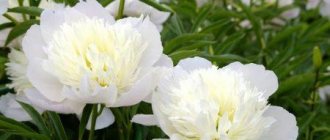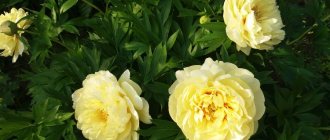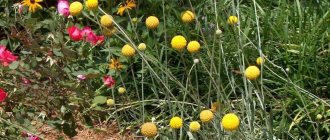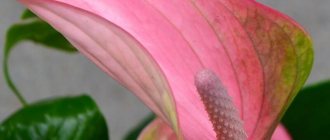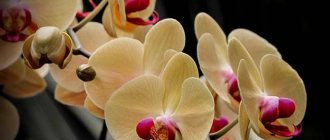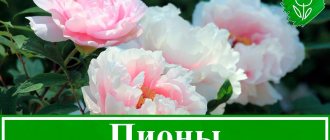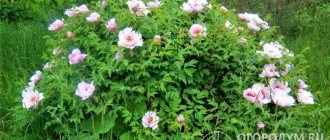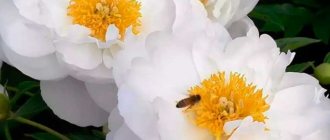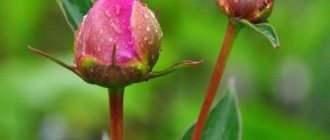Yellow color is not traditional for peonies; for many years there were only white, red and pink varieties of the most common among gardeners - the herbaceous peony. Breeders worked hard to obtain a yellow tint from the herbaceous variety.
At first, we managed to produce cream flowers with a barely noticeable yellowness, which disappeared soon after the bud opened. Later, the sunny shade was fixed in the genotype of the plant and dozens of varieties of yellow peony appeared to the world.
Brief description and characteristics
The culture was bred by Japanese breeders more than half a century ago from a combination of tree and herbaceous species. Being a hybrid, it differs somewhat from the popular red, white and pink varieties both in planting characteristics and in the duration of flowering.
Peony yellow
On average, yellow peonies delight gardeners for 3-4 years. The shrub reaches a height of 90 cm–1 m, flowers can grow up to 20 cm in diameter. Flowering period: late May - early July, depending on the variety.
Application in landscape design
Peonies have always been popular in landscape design. Yellow shades look especially advantageous on the site. This is one of the few plants that can be planted in a separate flower bed on a hill or green lawn.
Yellow peonies can become the centerpiece of the garden if you place them at the front entrance of your home. Designers advise planting them in relaxation areas near your favorite rocking chair or near an open kitchen. Flowers can exist next to garden scented geranium or white tansy. Such a neighborhood will favorably emphasize the yellow color, but will not hide the advantages of other plants.
Note! It is not necessary to combine peonies with other flowers, since they have an incomparable advantage over them in shape and height.
Golden Chariot, Golden Wheel or Huang Jin Lun or
Considered a collection variety. The Chinese claim that the “Golden Chariot” is the only yellow peony, because everything about it is yellow: the leaves are yellowish-green, the buds, and the rhizomes. Although it is also known that this is one of the rare yellow peonies with a completely green trunk, while most varieties have a reddish one. Other names of the variety are “Aurea”, “Minuet”, “Goldmine”, “Oriental Gold”, “Yokihi”.
“Golden Chariot” is a variety of herbaceous peony, rightfully recognized as the best non-fading yellow peony. Exported from Manchuria to Japan in the 1930s, where it became widespread and called “Yokihi”.
Perennial plant, spreading bush shape, strong stem (90 cm). A beautiful crown-shaped flower, 15x9 cm in size, with a fragrant scent. Frost-resistant, unpretentious, adapts to any soil, can grow without special care, but still prefers a sunny place protected from the wind or a place with openwork shade.
Popular varieties
Apple varieties: the best red, yellow and green varieties
The world's first yellow peonies were very dull and lost their color in the sun, turning into a semblance of their white relatives. Thanks to modern breeding, all three types - herbaceous, tree-like and hybrid - can have any shade: from soft yellow to honey.
Herbaceous
Herbaceous yellow peony is one of the most common varieties in Russia. It includes 7 representatives and is distinguished by a delicate aroma and natural creamy yellow color.
Herbaceous yellow peonies
Varieties:
- Yellow peony variety Lemon-chiffon. It was developed in the Netherlands and quickly became popular throughout the world. With its rich, lemony tone and incredible height, it regularly ranks at the top of color charts. The diameter of the flower reaches 22 cm.
- Golden chariot. Considered one of the favorite flowers in China. The bud is double, has a natural yellow color, reaches 15 cm in diameter, resembling a crown in shape. Blooms mid-season and is ideal for cutting.
- Variety Golden Halo. Pale yellow in color. It grows no more than 70 cm, the diameter of the flower is up to 13 cm. It is unpretentious when combined with other flowers.
- Sunny fight. Terry, distinguished by a delicate creamy color. Plant height – up to 75 cm, flower diameter – up to 16 cm.
- Golden Wheel. It is distinguished by a yellow-green hue, spreading shape of the bushes and a height of up to 90 cm. The diameter of the flower is up to 15 cm. It begins to bloom in May. It is unpretentious in terms of soil composition even in coniferous areas.
- Gold Mine. Leads at the beginning of flowering. This double flower has a light yellow color and a diameter of up to 16 cm. It reaches a height of 80-90 cm. It is frost-resistant.
This is interesting! The variety Sunny Boy or Sunny Boy is a popular exhibition plant, but is quite rare in private gardens and summer cottages.
Tree-like
Tree peonies got their name because of their similarity in shape to small trees. They are sometimes called deciduous shrubs. They can grow up to 2 m. The stems grow with renewed vigor every season and do not wither in the winter.
Tree-like yellow peonies
Popular varieties:
- Variety Midday Heat. It has a pronounced lemon color, rich aroma and a height of up to 120 cm. It blooms from late June to mid-July. In hot summers you can expect to bloom twice.
- Yellow Yao. One of the most frost-resistant species. He is less susceptible to diseases than others. It can begin flowering in mid-April. Typically one plant has about 50 flowers per season.
- Gold Placer. One of the brightest yellow peonies. It has an orange-honey color with pink splashes. It begins to bloom in early June.
- Variety Academician Sadovnichy. The lowest of the trees. Its stems reach a height of 1 m. The flowers are pale yellow with a pink tint.
- Flowers Souvenir de Maxime Cornu. They have a rich creamy yellow color with a pink border around the edges. Flowering begins no earlier than mid-July. When cut, it is most resistant to wilting.
- Peony Kuindzhi. It has a calm yellow color with a red tint closer to the middle. It is the tallest of the tree-like ones - up to one and a half meters. There are a lot of flowers on the bush, they quickly replace each other and fall off.
This is interesting! The aroma of many tree peonies is reminiscent of citrus fruits.
Hybrid
These yellow peonies are a unique combination of the best qualities of their herbaceous and hybrid peonies. They are easy to plant and care for, but have lush, long-lasting blooms and rich colors.
Hybrid yellow peonies
Popular varieties:
- Variety Viking Full Moon. One of the most unpretentious. It has the shape of a herbaceous bush. The flowers are small, yellow-green with a bright burgundy disc in the center.
- Bartzella. One of the most popular varieties. It is distinguished by a tea shade with red splashes and huge double flowers. The herbaceous bush reaches a height of 100 cm. It usually blooms in early July.
- Going Bananas. The color resembles a banana and is distinguished by simple flowers no more than 20 cm in diameter. The height of the bush is about 65-70 cm. Flowering begins closer to mid-July.
- Variety Singing in the Rain. One of the most expensive and luxurious. The shade is reminiscent of grapefruit pulp, the aroma is light and unobtrusive. The height of the stems is up to 80 cm, the diameter of a semi-double flower is up to 20 cm.
- Canary Diamonds. It is distinguished by lush flowering and a bush height of up to 1 m. The color is rich, yellow with a creamy tint. It is universal in planting, can grow in almost any soil, and is frost-resistant.
- Border Charm. It is distinguished by a creamy shade of lush double flowers with a diameter of 20 cm. The height of the bush is 50-70 cm. The pronounced aroma is reminiscent of the smell of citrus fruits. Blooms profusely and is frost-resistant.
- Variety Yellow Crown. It is the yellowest of all the varieties described above, the flowers reach 15-17 cm in diameter. Yellow Peony begins flowering in mid-May and is characterized by long flowering. When cut, it decorates bouquets for an average of 7-10 days.
Note! The Singing in the Rain variety got its name due to its high resistance to heavy rain and cold.
Lemon Griffon, Lemon Griffon
Compact bush. Huge (18-22 cm in diameter), almost spherical, double and semi-double flowers. The color of their petals is pale lemon. As it blooms, it changes from snow-white to cream with yellowish stripes, and pink spots may be observed in some places.
To the touch, the flower seems to be made of chiffon, like a dense ball with horizontal lower petals. The stigmas of the pistils are purple.
The stems are strong, 80 cm high, the foliage is dark green.
Basic rules for planting and growing
Ito-peonies - what kind of hybrid species is this, planting, propagation and care of hybrids
These yellow flowers are planted in open ground using root cuttings branched from the bush. The division operation is carried out independently or a ready-made cutting is purchased. When purchasing, they are guided by a 3-4-year-old peony division with 2-5 growth points (or buds). The seedling should not have suspicious growths, be too dry or wet. It is better if the root system is about 20 cm long.
Planting a yellow peony in open ground
Timing and features of planting
Planting usually occurs in the fall, around mid-September - a month before the onset of frost. The root system should send out shoots before the onset of cold weather.
Peonies planted in spring have a weak, undeveloped root system that is prone to disease. This is explained by the fact that in the spring the peony’s task is to bloom, so all its strength goes to the formation of buds and leaves. Planting in spring is possible from mid-April to early May. It depends on the timing of flowering. For example, the Yellow variety peony begins to form buds already in early May, so it is planted no later than the beginning of April.
Important! After planting in open ground, yellow peonies bloom for 3-4 years.
For successful growth and flowering, you need to choose the right location. Places rich in sunny color throughout the day are suitable. The flowerbed should not be placed closer than 1 m to the walls of buildings and structures on the site. The shade is detrimental because it slows down flowering.
The recommended distance between bushes is from 1 to 1.5 m. The landing site should not be subject to flooding during rains or melting snow.
The place for the peony should be sunny
Particular attention is paid to the choice of soil. Cultivated loamy soil is best suited. The key recommendation will be good moisture holding capacity and drainage of the soil for planting. The soil should not be excessively wet.
Helpful advice! To make the soil neutral or moderately acidic, add a bucket of sand to the hole when planting - if the soil is clay, or a bucket of clay - if it is sandy.
The seedling should be carefully inspected before planting. Damage or signs of rot are trimmed with a sharp knife and then treated with wood ash. If the seedling is dry, there is no point in planting it.
Step-by-step instructions for planting yellow peonies
- Dig a hole up to 1 m deep, the bottom of which is lined with a drainage layer (gravel or garden brick).
- Fertilizer is prepared right in the pit. It can be specialized for perennial plants or a mixture of humus, ash and Superphosphate with soil.
- Soil is applied to the fertilizer around the edges.
- A seedling is placed in the hole, straightening its roots to the sides and down. The buds on the seedling should be 3-5 cm underground.
- A little river sand is poured around the seedling and carefully covered with soil.
- Form a watering circle and water carefully.
After planting, use at least 10 liters of water for each peony bush
Growing a flower
Sedum varieties and types - the best varieties for the garden
The description of any variety provides complete information about planting rules and possible difficulties with cultivation, but for all varieties almost everything is standard.
Landing
Planting with root cuttings
The bush is dug up and taken out of the ground. The root system is washed with water and left to dry for several hours. This approach will help reduce its fragility and accidental damage.
Important! Planting work is carried out in early spring or late autumn.
Selecting a location
Plants should not be planted near houses, fences, or large trees. If the site is located in an area with close groundwater, then the bushes are planted on raised beds or create good drainage.
How to prepare the soil and flower for planting
The planting pit is prepared several weeks before the target date. It is dug up to 60 cm deep and 70 cm wide.
Step by step landing procedure
The prepared bush is divided into several parts with 3-5 buds and part of the root system up to 15 cm. Violation of the rules will lead to a lack of flowering. Further procedures follow the algorithm:
- The seedling is placed in a solution of potassium permanganate for disinfection for half an hour.
- Afterwards, they are immersed in a heteroauxin solution - 1 tablet is diluted in 10 liters of water.
- After removal, allow to dry, and cover the cut areas with crushed coal.
- The bush is planted in the hole on a prepared soil cushion.
- The free space is covered with earth; the layer above the kidneys should not exceed 5 cm.
- Watered.
Note! In the first year after planting, peat mulching is carried out with a layer of up to 7 cm. In the spring, it is not removed until reddish sprouts appear. Afterwards they loosen the soil.
Planting with seeds (for selection)
Seed propagation is practically not used by amateurs. When sowing, most of the varietal characteristics disappear, the flowers take on a different appearance than that of the mother plant.
When planting seeds in open ground, their germination can occur in 2-5 years. The material collected in the fall needs urgent sowing (the depth of the holes is about 5 cm).
When planting in boxes, warm and cold stratification is carried out. Seed germination will take 3 months.
Seed stratification
Rules of care
Canadian roses - the best varieties, planting and care in open ground
After planting, the flower is watered moderately, avoiding excess moisture. If peonies were planted in the fall and there is heavy rain, then additional moisture is not required. In spring and summer, peonies are watered on average once every 7-10 days. Watering usually ends in late August - early September.
Careful loosening of the soil around the bush is necessary both after watering and after rain, after about 2-3 hours. Fertilize the plant after the active flowering season, in August - September. In October - November, during the period of frost, the plant is cut to a height of 10-15 cm and covered for the winter.
Mulching a peony bush
Particular attention is paid to mulching - the process of fertilizing with organic fertilizer. In the first year of planting, peat or humus is scattered around the roots of the yellow peony. In exceptional cases, horse manure is used.
Important! It is strictly forbidden to use dry straw or fallen leaves, as they create an environment for pathogenic bacteria.
For the purpose of preventive treatment, stove or wood ash is added to the soil around the rhizome, which protects against many diseases and parasites. If necessary, the plant can be mulched with compost every autumn.
Academician Sadovnichy
Another variety of tree peony. Named in honor of academician V.A. Sadovnichy. - an outstanding Soviet and Russian mathematician, a major specialist in the field of computer science and applied mathematics.
Peony “Academician Sadovnichy” is a good winter-hardy hybrid, bred on the territory of the Moscow State University Botanical Garden. Can reach one meter in height. The flower resembles a bowl with a diameter of 15 cm. A dark red spot in the center, bright yellow, semi-double petals.
Flowering is later, in mid-June, long lasting – 10-15 days. Bush 70-100 cm high, spreading. Leaves are medium sized, green. The variety is resistant to diseases and pests.
Features of flowering
The main difference between yellow peony and other varieties is the long period of relatively abundant flowering. The time frame depends on the variety and planting location. On average, they bloom from mid-May to mid-July for 1 to 3 weeks: non-double – 5-10 days, double – 15-20 days, semi-double – up to 2 weeks. The peak of active flowering of most varieties occurs in the first two weeks of June. Rare varieties can survive until early August.
In the first two years after planting, it is recommended to pick off the buds as soon as they appear. This helps the plant to form a strong root system in order to have lush large flowers in subsequent years.
During the flowering period, special attention is paid to care: they are fertilized with special fertilizers with potassium or phosphorus and watered regularly.
Abundant flowering of yellow peonies
If peonies do not bloom, the reasons may be:
- Incorrect planting. The analysis takes into account the composition and moisture content of the soil.
- Wrong location. The parameters of the flower location and the possibility of transplantation are assessed.
- Lack or excess of nutrition. Feeding should be done according to the schedule.
- Excessively active previous flowering.
- Plant age: usually 5-6 years after planting, flowering activity decreases.
- Fungus and other diseases.
- Bare rhizome. In this case, add nutrient soil to cover the roots.
History of selection of yellow peonies
The history of hybridization of peonies and the development of yellow color in flowers is in itself very fascinating. The incredible shades of pink and milky watercolor of these flowers have won hearts for thousands of years, but in the 20th century, with the development of landscape design, and the industry as a whole, the desire to obtain a peony with an unprecedented yellow color quickly grew into an obsession.
The appearance of yellow peonies did not in any way change the popularity of peonies with much more typical shades, but still became a sensation and added an exclusive, luxurious option to the list of available design options, which is still hunted by both botanical gardens and collectors, as well as private gardeners - true fans of this amazing plant.
The entire history of breeding yellow colors in herbaceous peonies can be divided into three periods.
Stage 1 - attempts to achieve a yellow color by crossing herbaceous peonies.
Until 1948, active selection was carried out all over the world and largely unsuccessful attempts to obtain varieties with a yellow color continued without drastic measures. As a result of selection based on the large-leaved peony, Mlokosevich and Vitman, which by nature partially have the yellow flavone pigment, modest varieties were obtained that only had individual yellow details.
During this period, the greatest contribution to the hybridization of peonies was made by Earl White, who obtained the first of the conditionally yellow varieties, “Claire de Lune,” in which the yellow pigment appeared so weakly that it only gave the flower shades of cream and ivory.
Ballerina , White Sands, which are still in great demand today ). White Sands), Cheddar Cheese, Golden Bracelet , Moon , etc.).
Stage 2 of Ito-peonies selection
The interspecific hybridization of herbaceous and tree peonies by breeder Toichi Ito became a long-awaited breakthrough in peony breeding. Crossing the yellow peony (Paeonia delavayi), the only peony in which the yellow carotenoid pigment was persistent and allowed hybridization without loss of tone, with a herbaceous semi-double peony , resulted in the first ever variety with picturesque yellow flowers.
The official year of the “start” of yellow peonies is considered to be 1948; the full flowering of plants with a unique color took place after the death of the breeder. Until 1967, when the rights to the hybrids were sold, 4 more yellow Ito hybrid varieties bloomed, and today they remain stellar.
Stage 3 - acquisition of rights to hybrids and the beginning of the American history of peonies
The beginning of the history of yellow peonies on the territory of the New York peony nursery of Louis Smirnov with the official registration of varieties under the name Ito-Smirnov marked the period of replenishment of the collection of varieties and the beginning of the modern history of yellow peonies.
Registered in 1974, the four core varieties began to spread throughout the world, and the designation “Ito hybrids” became not only a registered class of peonies by the American peony community, but also a protected trademark. Other American breeders were also actively working to expand the palette of yellow or almost yellow peonies, and for two decades a new name from the Ito hybrid section appeared in catalogs almost every year.
Since the late 80s of the last century, the selection of Ito hybrids, as well as peonies in general, cannot boast of positive dynamics. Almost all varieties on the market were bred quite a long time ago, and if new products appear, they are far from impressive in quantity.
Yellow peonies after flowering
Each flowering period should alternate for shrubs with properly organized rest and rest. To get decent flowering next year, you need to do the following:
- Transfer. It is carried out once every 2-3 years to renew the soil. If the plant begins to wilt and produce few flowers, replanting is performed immediately after the main flowering stage.
- Pruning yellow peonies immediately after flowering is not allowed. They are cut off towards the end of September.
- Preparing for winter. The root system is fertilized and some varieties are covered. Most yellow peonies are frost-hardy.
Varieties of pink and red tree peonies
The peculiarity of pink and red peonies is that each variety has an individual shade, unlike the others. The most delicate color and pleasant aroma have made them popular in all corners of the world.
Flowers of pink and red tree peonies have wide, rounded petals
Lantian Jay
An unusually beautiful chalk pink peony with many wavy petals. The flowering process begins at the very beginning of summer, and the garden is filled with a sweet, subtle aroma.
Lantian Jay is shaped like a beautiful pompom
Shima Nishiki (Shima-nishiki – Dao Jin)
An amazing creation of Japanese breeders. This variety appeared due to a natural mutation of the Tayo peony. As a result, the world saw a real masterpiece, consisting of almost white petals generously colored with cinnabar. Stripes and strokes of different widths intertwine with each other, forming natural patterns. In addition to the variegated one, this variety also has a completely monochromatic variety, which amazes with its rich red hue.
Shima Nishiki has about two dozen buds on a young bush
Rose powder (Fen he piao jiang)
Breeders managed to reproduce the shade of a delicate pink pearl, which shimmers, changing the depth of tone. The fragile beauty of this peony makes the heart skip a beat, and its ease of care makes this variety the most desirable among gardeners around the world.
Tree peony Pink powder feels good in Russian latitudes
Diseases, pests and ways to combat them
The main pests of flowers are viruses and fungi. Prevention of their occurrence is by following the rules of care and carefully inspecting the plants. Damaged areas of the flower are cut off with a sharp knife and burned. To prevent insects from getting in, flowers are planted as far as possible from potatoes, raspberries and strawberries. It is necessary to spray them with special solutions against aphids, bronze beetles and caterpillars.
Beautiful lemon peonies
Yellow peonies are beautiful plants that any gardener will love. They are unpretentious, frost-resistant, easy to care for, and consistently delight their owners with chic flowers in sunny shades.
Types of tree peonies
In China, all varieties of peonies are divided into many groups based on the names of the provinces in which they were bred. In world practice, a different classification has been adopted. It includes three large groups:
- Sino-European. This includes varieties with large flowers that consist of large petals. They can be in completely different shades: from light pink to rich fuchsia. The too large size of the buds causes admiration, but at the same time they quickly droop and no longer look so beautiful.
Tree peonies of the Chinese-European group are distinguished by large flowers - Japanese. Local breeders have developed original varieties with aerial flowers slightly smaller than those of the representatives of the Chinese group.
In their shape, the flowers of the Japanese group of peonies are similar to a bowl and are semi-double - Hybrids. The ancestor of all these varieties was the Delaway peony, which was crossed with one of the yellow species. Representatives of this group are particularly beautiful, as they subtly combine different shades.
Hybrid groups of tree peonies are distinguished by their unusual petal shapes
Tree peony in landscape design
There is hardly another shrub that can compare in the perfection of lines and riot of colors with the tree peony. This incredible plant gives complete freedom for flight of fancy and allows you to realize any idea. An ordinary garden plot turns into a fairy-tale garden, worthy of becoming the decoration of a real palace. Peonies are often used to decorate parks and squares to create elegant and formal compositions. As part of the garden, the tree peony (pictured below) will help recreate the atmosphere of an ancient park if you install beautiful wrought iron benches and original street lamps.
Tree peonies can be planted near open gazebos and swings
Attention! Spreading shrubs should not be planted as a solid wall, otherwise they will lose their charm.
The tree peony is a born soloist, and not every plant can make a successful duet. It is best to place a majestic silver spruce or bulbous flowers (crocuses, daffodils, tulips) next to it. Peonies will look spectacular against the background of various decorative elements, such as garden statues, small fountains, as well as beautiful architectural structures. Bushes can be planted near open terraces so that you can enjoy the beauty and delicate aroma of these amazing flowers while having leisurely conversations and drinking tea.


